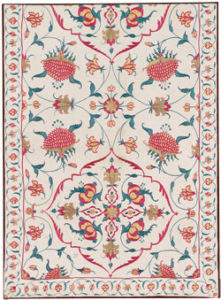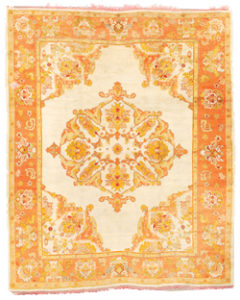A Brief History of Rugs
The oldest known carpet was discovered frozen in a Siberian tomb from the 5th century BC, although little is known about carpets until the 13th and 14th centuries as few artifacts have survived. The making of carpets as we know them today likely began with pastoral nomads such as the Kazakh, Kirghiz, and Turkmen in southern Asia over 2,500 years ago. The weaving areas that produced the majority of antique rugs we see today are Persia (now Iran), the Caucasus (southern Russia, bordering northwest Persia and Azerbaijan), Anatolia (Turkey), Afghanistan, Turkmenistan, China, and India.

Although carpets began coming to Europe in the 16th and 17th centuries for palaces, royalty, and the wealthy of the East European market, they waned in popularity in the 18th century as European carpets came into vogue. There was a renaissance of interest in the 19th century as Persian, or oriental, rugs came back into fashion, partially due to the romanticized visions of the Middle East created by “orientalist” painters. In the mid-19th century, European firms went into Persia and set up workshops to weave for export to the West on a large scale for the first time, marking the transition from rugs made for personal use to rugs made for commercial purposes. These workshops designed rugs with patterns and colors that would appeal to the Europeans and English, while local firms combined the rich history of classical carpet design with new popular designs.

In the second half of the century, there was a very rapid evolution of design based on feedback from the west, the need to speed up production, and the continued commercialization of the industry. Therefore, it is widely recognized that the closer a rug is to the middle of the 19th century, the more “pure” the design form. By the 1920s, with the exception of a few geographic areas that remained true to the 19th-century aesthetic, workshop rugs had become so standardized in their designs, colors, and quality that they approached “department store” status, meaning that you could get the exact same design from the same workshop in a number of standard sizes. Nonetheless, there were still pockets of production into the 1930s that employed primarily natural dyes and had better design integrity than these mass-produced rugs.
There are rugs in museums and private collections dating back to the 14th century, and even earlier in some instances, which provide important information and clues as to how rug designs evolved over time. Because of the rapid evolution from popular discovery to broad commercialization, we see a relatively narrow historic window of commercially available, high-quality antique rugs woven in the 19th to early 20th century. This has created a limited supply of such rugs and creates both the challenge and reward of finding the perfect rug.
